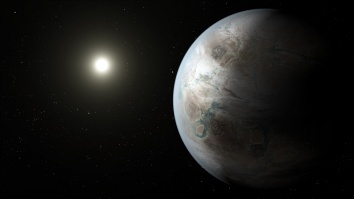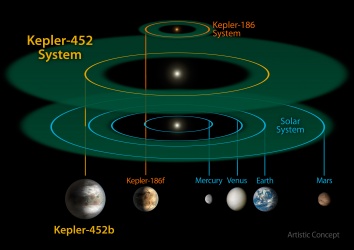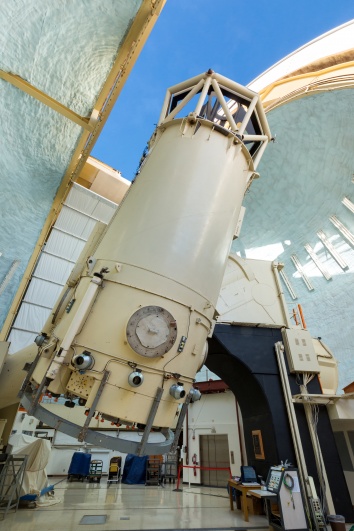Texas Astronomers Help Find Earth’s Older, Bigger Cousin
23 July 2015
AUSTIN — University of Texas at Austin astronomers working with NASA’s Kepler mission have helped to discover the first near-Earth-sized planet around a Sun-like star in the “habitable zone,” the range of distances where liquid water could pool on a planet’s surface. They used the university’s McDonald Observatory to help confirm the finding, which has been accepted for publication in The Astronomical Journal.
“We are pushing toward Earth 2.0,” McDonald Observatory astronomer Michael Endl said. “This planet is probably the most similar to Earth yet found.”
The planet, Kepler-452b, lies about 1,400 light-years from Earth in the constellation Cygnus. It’s 60 percent larger than Earth and is considered a “super-Earth-sized” planet. Its mass and composition are not yet known, but previous research suggests that a planet of its size has a better than even chance of being rocky. Its orbital period is similar to Earth’s, at 385 days.
Once the Kepler spacecraft identifies a possible planet, “you need to do a whole array of follow-up,” Endl said. “This is where the power of McDonald Observatory comes in.”
He explained Kepler data provides the ratio of a potential planet’s size to the star’s size, but not the actual size of either. So once Kepler finds a planet candidate, telescopes at McDonald Observatory and elsewhere get to work characterizing the host star in as much detail as possible.
“If you know the host star, you know the planet,” Endl summarized.
The UT Austin Kepler group probed the star with the Harlan J. Smith Telescope at McDonald Observatory in West Texas. Together with similar measurements from Whipple and Keck observatories, the data proved that the planet is real (that is, not a starspot or other false signal picked up by Kepler). Their measurements helped pin down the planet’s size to between 1.4 and 1.8 times the size of Earth — a size that makes theorizing about the planet’s makeup a bit tricky.
“At around 1.5 times the Earth’s radius there seems to be a transition going on from predominantly rocky planets to planets that contain more volatiles — ices,” Endl said, “which would make it a mini-ice giant.” In the case of Kepler-452b, “we don’t know if it’s a big rocky planet or if it’s a mini-Neptune.”
The McDonald Observatory and other ground-based measurements also proved that the host star, Kepler-452, is 1.5 billion years older than the Sun, and is 10 percent larger and 20 percent brighter. It has the same temperature as the Sun, and like the Sun, Kepler-452b is classified as a G2-type star.
“Kepler has recently shown that virtually all of the stars that we see in the sky probably host planetary systems,” said UT Austin research professor Bill Cochran, a co-investigator of the Kepler mission. “Now we are discovering that a significant number of those systems are very much like our own and may have the capability of being habitable.”
While planets smaller than Kepler-452b have previously been found in their host star’s habitable zone, this is the first small planet orbiting a star very similar to our Sun. This discovery, and the introduction of 12 new small habitable zone candidates Kepler has uncovered, many around Sun-like stars, marks another milestone in the journey to understand our place in the cosmos.
“We can think of Kepler-452b as an older, bigger cousin to Earth, providing an opportunity to understand and reflect upon Earth’s evolving environment," said Jon Jenkins, Kepler data analysis lead at NASA's Ames Research Center. "It is awe inspiring to consider that this planet has spent 6 billion years in the habitable zone of its star, longer than Earth. That’s substantial opportunity for life to arise, should all the necessary ingredients and conditions for life exist on this planet.”
Endl explained that a star’s habitable zone changes over its lifetime. As a star ages and becomes brighter, the more intense radiation pushes its habitable zone farther out. Astronomers estimate how long Kepler-452b has spent in its star’s habitable zone by combining the star’s brightness and age with their measurement of the planet’s orbit.
The Kepler team at McDonald Observatory has been involved with the mission since before its launch in 2009. The team follows up planet candidates with the Harlan J. Smith Telescope, and next year will resume Kepler follow-up observations with the refurbished 10-meter Hobby-Eberly Telescope, one of the world’s largest.
— END —
Media Contacts:
Rebecca Johnson
McDonald Observatory PIO
512-475-6763
Michele Johnson
NASA Ames Research Center PIO
650-604-6982
Science Contacts:
Dr. Michael Endl
McDonald Observatory Research Scientist
512-471-8312
Dr. William Cochran
McDonald Observatory Research Professor
512-471-6474









